Text
i remember adults telling me, as a kid, to listen to doctors and get my flu vaccine and any shots i could because they remembered Before.
then they started fighting Covid precautions.
i remember adults telling me, as a kid, that the ozone was disappearing and the earth was dying and we needed to recycle and save the planet.
now my parents think climate change is a myth.
i remember adults telling me, as a kid, that racism was a plague, that we had to love and accept everyone, that we should never judge before walking a mile in their shoes.
then they told me that protesting for my Black siblings was wrong.
i remember adults telling me, as a kid, that we needed to give to the poor. working at soup kitchens. making quilts. collecting food and money and supplies. building houses. because it was the christian and just plain right thing to do.
now they look at me, on food stamps with their grandchildren, and lament the "welfare state".
i remember adults telling me, as a kid, that it was easier for a camel to pass through the eye of a needle than a rich man to enter the Kingdom of Heaven and that any rich man, especially an immoral one, should never run our country.
you can guess who they voted for.
i remember adults telling me, as a kid, so very much.
when did they forget?
83K notes
·
View notes
Text
Shogun (2024) Ep. 6 spoilers
Shogun really came out today with Episode 6 and said "we are coming for House of the Dragon's 'ex-besties turned rival and war crimes' throne this year" (no dig on HOTD btw, I am fully subscribed to both)
Also: I am here to once again uncritically say that Fumi Nikaido is everything I expected her to be in this role and more--and amazingly it's even more explicitly sympathetic to what would make the historical Chacha/Yodo as ambitious and grasping as she tends to be in other fiction.


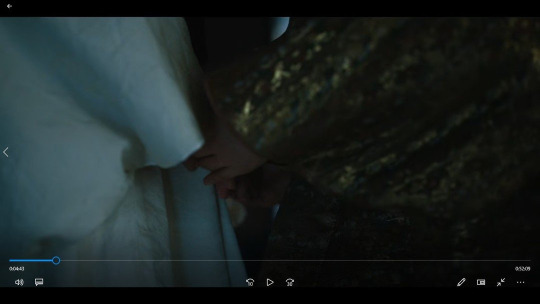
#shogun 2024#shogun fx#shōgun#shōgun 2024#shōgun fx#fumi nikaido#ochiba no kata#lady ochiba#rurihime#anna sawai#toda mariko#house of the dragon#game of thrones#rhaenyra targaryen#alicent hightower#shogun
18 notes
·
View notes
Text
One of my first (but hopefully not last) contributions to the emerging trivia on Shôgun:
Lady Ochiba / Ruri, the mother of the Taiko's heir Yaechiyo, is based on Lady Yodo/Chacha (1569-1615), niece to Oda Nobunaga and second spouse of Toyotomi Hideyoshi. We see her here as the primary moving force shoring up her son's position and the patron of Toranaga's rival Ishido.


Fumi Nikaido as Lady Ochiba, Shôgun, 2024
What makes the casting of this one very interesting is that Fumi Nikaido has played the actual role of Yodo/Chacha in a similar period production, the 2014 NHK taiga drama Gunshi Kanbei (which was primarily about Kuroda Kanbei, the strategist of Hideyoshi played by Junichi Okada).
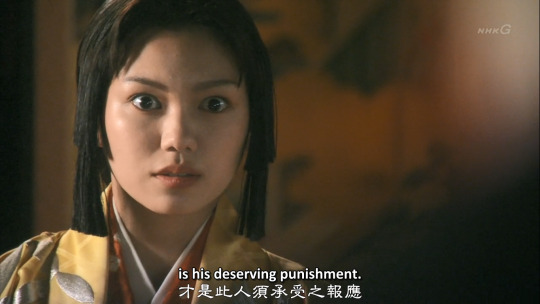

Fumi Nikaido as Yodo, Gunshi Kanbei, 2014
While there's enough hype for Toranaga (especially as he is portrayed by public favorite and producer Hiroyuki Sanada--rightfully so), I wish to highlight Fumi Nikaido's return to this role as it does help highlight the differences between how Lady Yodo is portrayed in fiction. (It does help that we have no shortage of it now--even if it's mostly in videogames like Samurai Warriors, Sengoku Basara or the more historically-faithful Nioh).
The material we have of Lady Ochiba so far is of a proud, haughty, even disrespectful woman--and perhaps it's not exactly far off from how Chacha is portrayed even in Japanese media. To some extent, even Gunshi Kanbei conceded to this especially in the episodes I'm referring with this photo--what with it precisely being the moment Yodo is fearing coming to pass. A mother seeking to protect her son's patrimony (and by extension, her agency and regency), it's a universal trope in feudal drama. What Shôgun does not give her yet (but Gunshi Kanbei took pains to establish) is the recognition that she is as much a victim of the warring era, turning her into a self-loathing monster only able to survive trying to make sense of it all, and maybe recover their agency in it. Clavell rightfully gave it to his main focus character, Lady Mariko (played very layered and well by Anna Sawai compared to her more recent outings--herself based on Hosokawa Gracia).
It truly amazes me that 10 years has yet to make much of a difference for Fumi Nikaido and this role. The woman whose position at the top was only made possible by misery and her playing by the cruel game of chaos, she portrays both versions with the edge, anxiety and palpable will of a woman who's lost everything before and is at the doorstep of losing them again.
#shôgun#shogun#samurai#shogun fx#shôgun fx#shôgun 2024#shogun 2024#fumi nikaido#chacha#lady yodo#yodo-dono#ochiba no kata#james clavell#lady ochiba
100 notes
·
View notes
Photo

Tokyo 2022 Pre-Conf. Day -1: Finding Shibuya After this morning's technical rehearsal, what we mostly have here are photos of me taking the transpo across Shinjuku City to Shibuya City, which isn't really much. I should perhaps thank being exposed to the Nagoya train system for 2 years that the confusion and congestion of Tokyo underground is no longer too intimidating to me. (The one thing perhaps I can say is that when it comes to the casual fashion of the youth and regular commuters I am following, clearly *Jujutsu Kaisen* wasn't exactly exaggerating.) That being said, today isn't specifically about aimless wandering. We actually managed to squeeze in two major sites for this afternoon before I went back to hotel, to be shared separately. Also: it is perhaps an indication of my continued looking for the familiar that the one moment I found a Shakey's, I immediately sat down and gobbled it for dinner. (at Shibuya City) https://www.instagram.com/p/ClV3IdSpE5v4fZWwnI-8jicKRVC9SR1VtLUMQc0/?igshid=NGJjMDIxMWI=
7 notes
·
View notes
Photo

The Road to PSCJ 2022 Tokyo: Pre-Event Day -2 Today's holiday (Labor Thanksgiving Day) became a good opportunity to travel to Tokyo and maximize my stay (not only for conferences, but actually seeing the area). Sadly, the rain doesn't let up as per forecast, so much of the road trip is staying in the bus and watching prepackaged shows. (Who knew watching French historical drama is very doable when you're stuck inside a bus.) So, once again, I land in a Shinjuku drenched with rain and unceasing billboard lights. I know there are recent conversations about how Japan is not (and should not) be defined by its continued usage in cyberpunk sci-fi settings, but considering it was most likely born in Shinjuku it is inevitable. We just need to make sure we don't catch any cold or illness here. We have a purpose after all. (at 歌舞伎町) https://www.instagram.com/p/ClTQOPOJH7oIiuCLgN-HGA_v9dxw_boeR-IhZk0/?igshid=NGJjMDIxMWI=
0 notes
Text
Ever since finishing Kamen Rider Black Sun yesterday, I've been struggling to think why does the opening titles sound very familiar and nostalgic.
I realized the title credits share the same BPMs/notes as "Madder Sky" of Code Geass R2.
#kamen rider black sun#code geass#madder sky#kotaro minami#kotaro nakagawa#kamen rider black#hidetoshi nishijima#tomoya nakamura#jun fukuyama
1 note
·
View note
Photo
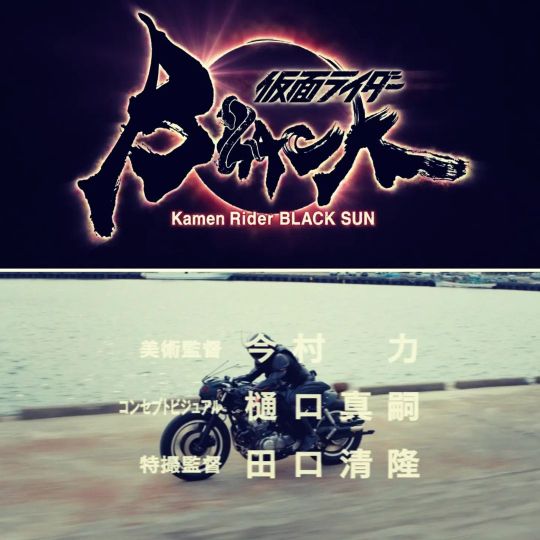
The opportunity to binge #KamenRiderBlackSun came to me the past weekend and I finished it today.
The series is an unapologetic attack and commentary on contemporary Japanese societal issues, the undercurrents of #unseenjapan that #cooljapan probably tried to paper over throughout the Olympics and decades of LDP rule, and it just grew keener with the assassination of Shinzo Abe and the near-interminable desire to demand change in a society unable to accept it. It is an attempt at portraying, through fiction, that Japan is more multicultural than it tends to see itself, it is harming its soul by denying that, and it deserves better by listening to its youth, and it better do so before they swallow them and their most vulnerable.
Perhaps it is inevitable that this will be another battleground in the role of political commentary/applicability especially when it is appearing in long-running franchises. This is currently the biggest dilemma of franchises like the ones owned by Disney (Marvel and Star Wars), not to mention fantasy (the recent tussles between House of the Dragon and The Rings of Powder for ex.). The fact that *Kamen Rider Black Sun* is in Amazon Prime further highlights this. And yet if Japanese fiction can begin coming to terms with contemporary issues through the medium of its classical heroes (the way *Shin Godzilla* and *Shin Ultraman* already did, not to mention *Shin Kamen Rider* will do soon again), why not this way?
It is a testament that *Black Sun*, based off *BLACK*, probably the most successfully exported Kamen Rider before the Heisei period, is the best way to do this unbridled revisioning. (I personally grew up on BLACK on IBC13 in the Philippines.) This series speaks not only to the child who grew up with Kotaro Minami/Kuya Robert, but to the man, scholar & advocate I grew up as.
This is an unrivalled opportunity to revisit how Kamen Rider stories are told, what kind of storytelling the original creator Shotaro Ishinomori is interested in, and what can heroism possibly mean in a post-nuclear, heavily polarized and infuriating time. It is finding your lines, those who will hold your hands and back, and passing them on.
#kamen rider black sun#kamen rider black#kamen rider#kotaro minami#hidetoshi nishijima#shadow moon#black sun#nobuhiko akizuki#tomoya nakamura#aoi izumi#kokoro hirasawa#bilgenia#takahiro miura#bishium#yo yoshida#lou oshiba#shinichi dounami#gaku hamada
46 notes
·
View notes
Text
Just realized something about Galadriel...
Because of this reveal from Rings of Power...
youtube
... this previous sequence from The Hobbit...
youtube
... is now essentially Galadriel kicking out her “one-night-stand” from her house.
I do not apologize for this disrespect hahahaha.
#the lord of the rings#the rings of power#charlie vickers#halbrand#sauron#benedict cumberbatch#necromancer#galadriel#morfydd clark#cate blanchett#the hobbit#battle of the five armies
35 notes
·
View notes
Text
I have this theory (idk if thats the right word) about House of the Dragon and Fire and Blood and House Velaryon.
Its established in Fire and Blood that this book is an in universe historical account told by collecting different accounts to create a complete timeline of events. However we also know that all these narrators and contributors are unreliable and biased. We also know that they are all white men.
However the TV show, we are told is the actual true account of what happened. We are watching the story as it unfolds that Gyldayn is trying to piece together many many years later. This is why book to show changes actually have an in universe reason. Details get lost to history.
But there’s also this interesting social commentary I’m starting to notice more and more with the changes the show has made from the book in how it adds dimension to female characters that wasn’t there before. Rhaenyra and Alicent genuinely loved each other. Their falling out was more than just about two petty girls in want for power. Alicent is more than just an archetypal evil step mom, actually she was the same age as Rhaenyra and forced to seduce a old man for her father’s ambition. These are the actual stories of women who to the in universe audience of Fire and Blood have been villianized by history because one dimensional, hyper emotional, shrewdly ambitious is how many men see women. And history is written by men.
History then is also written by white people. And white people white washing history to make them the center? Thats unheard of! So I present this idea about the race difference between HotD and F&B. House Velaryon was always black, and ok maybe by the time of Robert’s Rebellion generations had gone by and they weren’t noticeably melanated, but this was always what House Velaryon looked like during the Dance. However white people gonna white people (real or fictitious) and so when retelling this even they retold the story of the Velaryons as white.
I think that would be realistic and sad parallel for real life and how white our history has been made to be.
51 notes
·
View notes
Text
House of the Dragon’s “White Hart”: A History Lesson
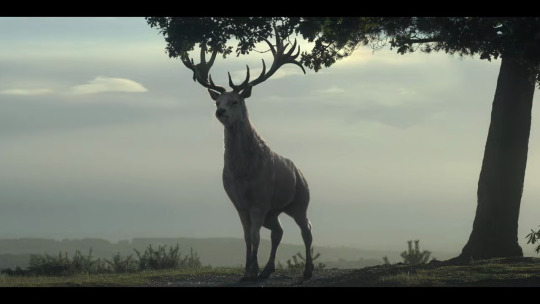
TL:DR: the usage of the White Hart is a blending of both European and Asian symbologies of monarchy. It’s very fun to unpack.
Quick note for everyone in here: Fire and Blood did not have this plot point. The White Hart only ever appeared in the first two books of ASOIAF as an alleged magical creature within Westeros. However, using the White Hart as a symbol is harkening back to hundreds of years of medieval warfare--especially considering the Ice and Fire franchise owes a lot to English medieval history.
First, for the English reference: the White Hart has notable royal heritage. To quote its Wikipedia page it was:
“... the personal badge of Richard II... In the Wilton Diptych (National Gallery, London), which is the earliest authentic contemporary portrait of an English king, Richard II wears a gold and enamelled white hart jewel, and even the angels surrounding the Virgin Mary all wear white hart badges.
Pretty straightforward, right? However, this gets additional layers when you take into account the personal history of King Richard II.
Richard II was a fore-runner in his time within the Plantagenet dynasty for culturally and politically asserting the idea of divine right--centuries even before James VI of Scotland wrote about it in his The True Law of Free Monarchies. There’s a reason William Shakespeare devoted the first play of his Major Tetralogy/Henriad to him, if only because the deposition of this king (however bad or inadequate he may be) poses massive questions regarding the justice or necessity of kingly rule altogether--if overmighty subjects can overthrow a king, what do we need a king for?
If overmighty subjects can overthrow a king, what do we need a king for? Is this not, indeed, the ultimate fate of House Targaryen? If one minor house such as the Hightowers can pervert and creep upon their authority--what does prevent other Houses from trying so? What prevents a Great House from subsequently asserting its claim--either of independence or the Iron Throne itself? The Storm Kings that descended into House Baratheon and the Stark Kings of Winter already gave us the answer in Game of Thrones.
But we go further. Let’s return to Richard II and the White Hart--and more importantly, how he turned into a tangible symbol of his political power--even at the expense of the unifying rule of the monarchy. See the Wilton Diptych:

The angels here are shown wearing the badge of the White Hart. As it happens, the White Hart was also recorded to be the livery badge of an armed man serving Richard II directly. Livery badges became identifiers of loyalty to a lord or knightly household retaining a fighting man for their services--in contrast to the traditional “feudal ideal” of land, lord and serf.
This informs Shakespeare’s own creative turn of phrase in the play:
Not all the water in the rough rude sea
Can wash the balm off from an anointed king.
The breath of worldly men cannot depose
The deputy elected by the Lord.
For every man that Bolingbroke hath pressed
To lift shrewd steel against our golden crown,
God for His Richard hath in heavenly pay
A glorious angel. Then, if angels fight,
Weak men must fall, for heaven still guards the right.
--- Richard II, II.3.55-63.
Armed service and knightly duty, therefore, is now equated to financial pay, not traditional values. To once again quote from Wikipedia:
These were badges in various forms made for a leading figure bearing his personal device, and given to others who would demonstrate by wearing them that they were in some way his employees, retainers, allies or supporters. They were especially common in England in the age of "bastard feudalism" from the mid-fourteenth century until about the end of the fifteenth century, a period of intense factional conflict which saw the deposition of Richard II and the Wars of the Roses.
The Diptych is therefore an artistic representation of Richard II’s megalomaniacal assumption of royal authority: he is not only king by right of men, but also by God--to the point that angels themselves are under his personal pay--the very definition of bastard feudalism. This referred to the phenomenon of standing armies maintained not in service to the realm, but to the highest bidder--the very phenomenon that sustained and won House Lannister its hegemony (at great cost) during the War of the Five Kings. We are given a more plain yet apt description of it by Robert Baratheon himself:
Robert Baratheon : Which is the bigger number, five or one?
Cersei Lannister : Five.
Robert Baratheon : [holds up his left fingers] Five... [clutches his right fist] ... one. One army, a real army, united behind one leader with one purpose. Our purpose died with the Mad King. Now we've got as many armies as there are men with gold in their purse, and everybody wants something different...
There is some irony, perhaps, in that the very symbol used in the real-life perversion of unifying monarchy is the one used to highlight the purity and royal majesty of the pre-Conquest kingship(s) of Westeros. However, there’s another straightforward usage of the idea of the “symbolic beast showing itself to the rightful ruler of the realm”.
Enter the Japanese kirin / Chinese qilin ( 麒麟 ).

The kirin is more like a mystical hodgepodge creature, not unlike an East Asian dragon. However, it is a matter of traditional folklore that the kirin is supposedly only shown to a strong warrior or ruler who promises to eventually unite a torn realm.
This very plot point pops up in a number of Japanese popular fiction involving the notorious Warring States/Sengoku Period of Japan--from something as straightforward as the 2020 NHK Taiga Drama Awaiting Kirin (Kirin ga Kuru), which portrays the tragic dream of the Ashikaga Shogunate and Akechi Mitsuhide to return to samurai valor--much as it is faced by the growing ambition of the relative upstart Oda Nobunaga...

... and even as family-friendly a franchise as Pokemon Conquest (where you seek to capture Arceus, the God of the Pokemon universe and the most kirin-like of all of then to unite a pastiche nation of the Sengoku Period in the Pokemon Universe).
All of this, then, once again casts the wasted pursuit of Viserys I and Rhaenyra’s effortless encounter with the Westerosi White Hart in greater symbolic light.

Practically the whole realm supports--and perverts--the process of the hunt in order to hand and guarantee that Viserys I will capture and kill the White Hart as a symbolic good omen for his newfound male “heir” Aegon II. Yet all they have to show for it is killing a base (albeit still impressive) brown deer. Viserys can’t even kill it with own strength of body--failing, faltering, necrotic and overdrunk as he already is.
Rhaenyra, after having a night of adventure with Criston Cole and proving that they are both worthy people, not just by the titles they were granted (Princess of Dragonstone and Knight of the Kingsguard), but by their own skills, encounter the White Hart for themselves. They have just proven themselves as capable hunters (if not even better), yet they eventually decide the better of it and let this majestic beast go. They respect the omen and their connection with the Realm. Their encounter with this beast of omens shows to us, the viewers, that they are perhaps to symbolically and emotionally attach to.
And yet, all the same, we are reminded of the gut punch: this is not medieval England. This is not Sengoku Japan. This is not real life, history or current. This is Westeros--where the worthiest are not granted power save what they can scrounge for themselves. Where the best intentions and attempts at peacemaking (even that of the still-kindly but increasingly-caught in the middle Alicent) are not rewarded with gratitude. Where the crows will feast on corpses because the high lords play their game of thrones. This is the Westeros at the eve of the Dance of the Dragons--where armies bought by the gold and steel of great houses will fight and die and burn in the name of loyalty to two competing claimants--one of whom was once the Realm’s Delight. Yet this still-hopeful princess is forced to go up against a realm that Rhaenys Targaryen aptly said would “sooner put itself to the torch” than accept a woman’s rule.
This is not real life. But it is a mirror of the ugly histories of men, of feudalism and the world that took us centuries to move away from, and yet still seem to be enthralled by in our fantasies that we inadvertently bring them back to the real world.
#house of the dragon#the white hart#white hart#house targaryen#house hightower#rhaenyra targaryen#princess rhaenyra#king viserys targaryen#viserys i#viserys i targaryen#alicent hightower#milly alcock#emily carey#paddy considine#criston cole#fabien frankel#kirin#awaiting kirin#kirin ga kuru#akechi mitsuhide#richard ii#richard ii of england#william shakespeare#nhk taiga drama#rhaenys targaryen#eve best#game of thrones#a song of ice and fire#pokemon conquest#arceus
15 notes
·
View notes
Text
Jason Lannister gives me the impression that he has Tywin’s position and sense of politics, a dab of Jaime’s charisma, a touch of Cersei’s sense of flair and Tyrion’s Season 1-3 seedy sketchiness. I can definitely see this man being the ancestor to all of them.
The amount of excitement I felt when I saw the Lannister sigil in todays ep.
And it only increased thanks to Jason Lannister's clownery lmao
35 notes
·
View notes
Text
I did not expect this crossover hahaha
Seriously, if they existed in the same universe I don’t think they might even stand a chance against handsome creepo Kirigan
I have to admit, Rhaenyra is so much better choice than Alina. The Morozova's Stag finally got it right!

Oh wait, his antlers were smaller, so HotD is before S&B... :(
91 notes
·
View notes
Photo

There’s so much to be said about this episode (not to mention the significant badass upgrade Laenor Velaryon got here compared to the source material), but my real question is:
Since this is the first proper look we had of Seasmoke, is it just me or is this the first dragon that looks actually related to Daenerys’s dragons? Seasmoke’s body shape basically looks like a leaner, more eagle-like Drogon. I was under the impression that Daenerys’s dragons were descended from another (Dreamfyre’s, unless I am mistaken).
#house of the dragon#game of thrones#a song of ice and fire#house velaryon#laenor velaryon#seasmoke#theo nate
8 notes
·
View notes
Text
Can I just say that as much as the entire model city in this title sequence is inviting a lot of speculation (not helped by the fact that the sigils are too far away to focus on), just the surfeit of the "rivers of blood" in the entire sequence is quite on the nose—yet it is still quite horrific when you think about it. Since this is after all about the upcoming Dance... They're just gonna be giving it away haha.
Still, as much as I would be on the side of those interested in new music, a higher pitched delivery of the GOT opening from Ramin is never unwelcome.
That opening sequence cured my depression
44 notes
·
View notes
Text
Quite possibly. Depending on how the later seasons (or even as early as S1′s final episodes) in the leadup to the Dance goes, Rhaenyra is either [potential book and show spoilers]:
going to spill the beans to her Velaryon sons and Targaryen sons, which is what will drive these kids;
the entire shitshow prevents her from even thinking about these; or
she at least manages to pass it on to Aegon III just before she is caught and killed--and our depressed Dragonbane king doesn’t bother to do any further because of what the Dance took away from him. Which is both infuriating and sad on its own.
But was the scene between Viserys and Rhaenyra some sort of foreshadowing that the Targaryens knew about the White Walkers/the Great War, kinda, and just never got to pass it on to their descendants because of what we’re about to witness with the Dance of Dragons or am I looking too much into this?
14 notes
·
View notes
Text
Since the HOTD Pilot leaked out earlier...
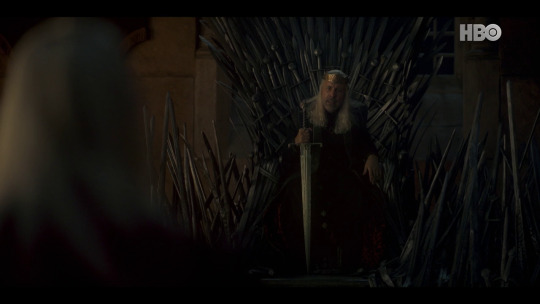
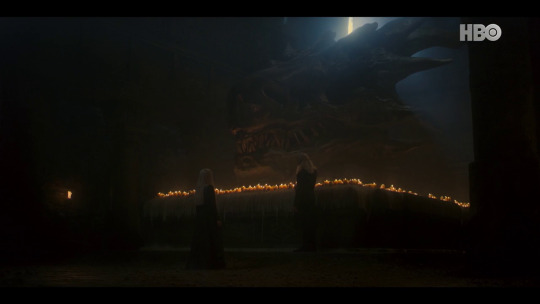

I chose to get in on it. Spoilers (both book and show) if you are waiting to watch legally.
Short verdict: I wouldn’t say the hype is real. But the character- and world-building it has was what drove me to watch Game of Thrones S1 when Ned Stark was at the heart of it. It deserves to be followed.
1. Reason I chose to watch earlier is because I have work tomorrow and those cannot wait--hence, this cannot either. I have been following the production promotion/content and hype-building of the official channels (but not the fandoms) considering how toxic that shit has been, and I guess that was truly justified. Here, I can watch the show as I see it. And even with the benefit of reading some spoiler-laden reviews (at least from the respectable newspapers), I am still pleasantly surprised to see it in action.
2. I have spent some time reading The Princess and the Queen AND Fire and Blood for the past years, so I would like to believe that at the very least I have a good sense of where they’re faithful and where they’re changing stuff. The stuff they change are not entirely jarring (even the age-gap between Rhaenyra and Alicent--if only because they tell a story with weight, even if not faithful to the texts).
Does it change the heart of the motivations, then, between the Crown Princess and the yet-to-be Queen Consort? Definitely. Do they become more humane/human? Quite so. Ultimately, at the heart of that fight was a succession between child and stepmother. It’s ultimately soap-ish when you reduce it to that component (and perhaps not as glorious as the glitter of the Seven Kingdoms would want us to believe). But then again what is history but the deeds and flaws of people, in all of its glory and ugliness?
In this, as of yet innocent young women saddled with the expectations of their fathers (Rhaenyra by Viserys I, Alicent by Otto), not to mention their desire to live out their own lives, nothing ends well. We say that the point of feminism is to allow women to choose their destinies--be they mother or powerbroker, be they confident or withdrawn. We are confronted here by two young women very much aware of what they are and what they want--and we know this world will crush it the way it crushed the aspirations of the elder Princess Rhaenys. We know the tragedy and how it will end. But now, at the very least, we care. And what else is among a story’s main objective than to make us care?
If only for this, Milly Alcock and Emily Carey deserve the positive reception--and I await what else they were given with before they are aged up into their succeeding actresses.
3. What I truly appreciate (especially since it was never entirely apparent in the original texts) was the explosive Throne room confrontation between Viserys I and Daemon over the “heir for a day” incident. You see here laid down, in its barest form, the clash of male entitlements in a feudal society: when power and blood ties are usually assumed to be one and the same, to be prioritized over (and even at the expense of) merit and good governance--played out and layered over the seriously-personal drama of brothers made to grow apart by the years, their dreams and their personal views of the world.
Were these two, sons of Baelon the Brave (a leagues better prince than either of them), perhaps made poorer men by the entitlements, resentments and expectations they grew up with? Perhaps. Daemon says people “must mourn [their] own way”--and whether he is being sincere not only for incident, lying out of his ass for the great faux pas, or inadvertently confessing to the state he’s been in throughout his life, I leave to the reader/watcher. (Shades of Elizabeth I speaking about the dangers of being ‘the second person’ in the kingdom, even.)
Yet all the same, it serves to highlight to Viserys I, a man whose head has lied uneasy ever since the crown laid on his head, a man that keeps being wounded by the Iron Throne both physically, socially and psychologically--what makes a person capable or not to “wear the crown”, and why the brother he loves can never be that. Viserys I is probably also already realizing, as much as he thinks he is doing his best, that he can never be that either--yet he will still try to the last until he can pass it on to Rhaenyra anyway.
(Does it clash with the supposed carefree Viserys I of the books? Very much so. But is this saddled-by-burdens Viserys I a more compelling king, a man who is trying to keep everyone onside even if he’s failing to do so, than someone who is too clueless about how badly he’s handling things? I daresay yes. Even Robert Baratheon, at his worst, knew that he’s doing a bad job but is only doing it the best way he can: keeping everyone on his side and indulging his pleasures--both Viserys and Daemon all on his own. The Usurper was as much Targaryen as he is Baratheon in the end.)
Paddy Considine and Matt Smith are given very good material in this moment, and I only hope they have more.
4. The stinging point for perhaps a number of the reviewers (and once again the fandom of this show still smarting from Season 8) was the explicit bridging of continuity between the mismanaged myth arc of the earlier show. Viserys I telling Rhaenyra that the Conquest to unify Westeros was supposedly about Aegon the Conqueror’s own vision of the Long Night is probably something that will not sit well with book purists and those who eventually lost sentiment for the entire threat of the White Walkers. (Let’s not even get into the colonial/imperialist undertones of the Conquest, not to mention state imposition in the service of national unity and facing climate change.) Or for that matter, explicitly invoking the memory of the fallen Daenerys Targaryen and her much-frustrating fall. This story will not change it, nor justify those, nor nuance those.
And yet it still tells a story, a comment, a message. That even the best of intentions, when faced with the realities of the desires and set ways of men, will be perverted and lost in the rigmarole and rigidity of the ages. Was the supposed ‘salvific mission’ of the Iron Throne enough to justify the fire and blood shed? Perhaps not. But once again, this is the story of the Targaryens. This is their view in their self-elevated perspective--much as the reign of King Jaeherys I gave them enough justification and enough disappointment on the idea.
This is how they see the world--governed by the magics of lost Valyria, the magics they still hold, the mysteries of the Seven Kingdoms they have (and will tragically never) uncover, and the vagaries of the men they rule. This was and still is the tragedy of Westeros: that the capability to understand the unknown--be it the supernatural or the hearts of other people outside their families and domains, is always stifled. That words are never given the chance because humans (even the Targaryens themselves) are so easily swayed by fire and blood. Archmaester Gyldayn once asked, “Who can presume to know the heart of a dragon,” when speaking of either the fire-breathing creatures or the Targaryens themselves. And yet Viserys and Rhaenyra know they are but humans. And these humans have flaws that are very recognizable. Flaws that will lead, much as they claw and fight and dream and hope otherwise, to the Dance.
So yes, the character- and world-building it has was what drove me to watch Game of Thrones Season 1 when Ned Stark was at the heart of it. The fact that I am indeed being reminded of the best and worst of Robert Baratheon and Daenerys Targaryen, spread out well amongst their ancestors (and memorably performed by both Mark Addy and Emilia Clarke) can only be good.
Perhaps this in the end was truly what we wanted from this franchise. That when words and human interactions happen, they are given weight. That when characters are put on the path towards tragedy and misery, they are given by their writers and producers very relatable and comprehensible motivations. That when it inevitably leads to violence, it is not for the sake of it, but because a point is being made and the audience is being asked to reflect (be it in introspection, horror or rage) and turn it through for themselves. Brecht has been giving us this lesson for the past decades. In a post-Breaking Bad and Better Call Saul world, perhaps there is really no further justification to not do so.
At least in this, House of the Dragon’s pilot succeeds. In this, perhaps we are being invited to once again dare have faith in George R.R. Martin’s world and stories, at least as they are brought to life on screen. Just this once, maybe we can do so and be rewarded.
#house of the dragon#rhaenyra targaryen#milly alcock#emma d'arcy#alicent hightower#emily carey#viserys i targaryen#paddy considine#daemon targaryen#matt smith#otto hightower#rhys ifans#robert baratheon#mark addy#daenerys targaryen#emilia clarke#ned stark#sean bean#rhaenys targaryen#eve best
31 notes
·
View notes
Text
You know I wanna get mad at this take since the Corinthian is way older than anybody from Jujutsu Kaisen...
But Neil and the team decided he had to be more stylish than the white tank top creep he originally was in the comics, and hence here we are. I'll let this slide.


i love the corinthian's actor so much, but literally the first thing i thought and kept thinking as i saw him was they fucking anglicized nanami kento from jujutsu kaisen like

LOOK
they anglicized him and put him on a moral 180
108 notes
·
View notes